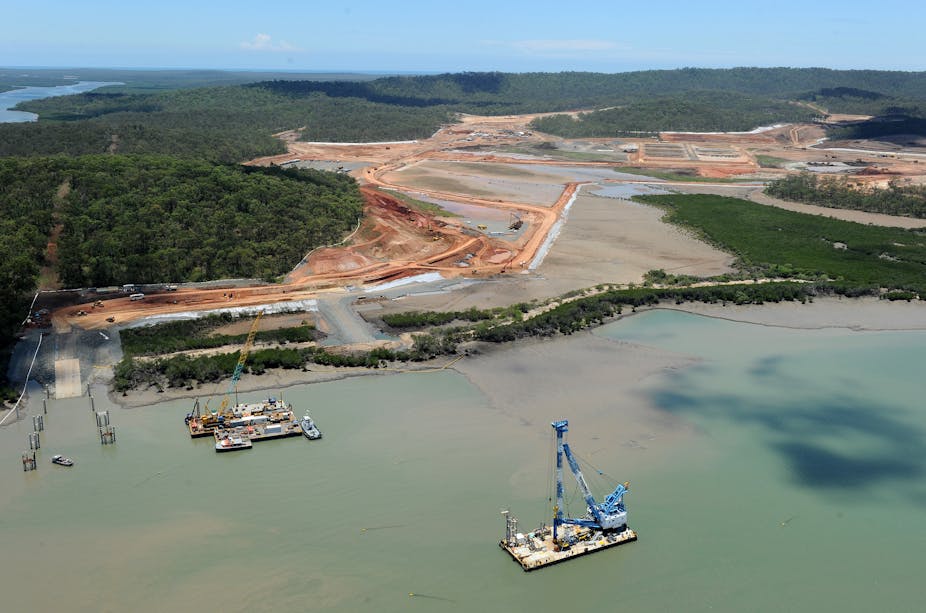The large Queensland liquefied natural gas (LNG) projects currently under construction will begin production over the next two years. Exploiting previously unused reserves of coal seam gas, the LNG produced will be sold at an international price which far exceeds the current price of natural gas being paid by industries and households in Eastern Australia.
The boost to exports from LNG will assist in cushioning the current terms-of-trade contraction, leading to increased real GDP and welfare for the national economy. But this is only one part of the overall story.
Through competitive pressures, the price premium received for unconventional Queensland gas will lead to increased prices for gas throughout Eastern Australia. This will increase costs of production for energy-intensive industries. For those industries (and regions) which cannot pass on the cost increases, production and employment will most likely fall as a consequence.
Recently economic modellers at the Centre of Policy Studies (CoPS), Victoria University, have been simulating future trajectories for the Australian economy and its states and territories designed to provide a balanced assessment of the costs and benefits of the new LNG projects. Specifically, the modelling has looked at the impacts of:
the construction and operation of three large LNG projects in QLD utilising gas generated, in part, from unconventional coal seam gas reserves in QLD; and
increases in the East Coast gas price to international parity for LNG.
The three LNG projects (QLD Curtis LNG, Gladstone LNG and Australia-Pacific LNG) consist of 6 LNG trains, built at a total cost of around A$60 billion. The projects are located around Gladstone and utilise coal seam gas in the Surat and Bowen Basins. When fully operational after 2018 the projects will be exporting LNG to the value of around A$10 billion each year.
It is assumed in the modelling that when all of these projects are in full production, the gas price in the Eastern states (all states and territories other than WA and NT) will rise through competitive effects to reflect international LNG prices. The current average price received by gas producers in the Eastern states is around $4.50 per Gj. The average price in 2011 was around $3.25 per Gj. It is estimated that the LNG-parity price in 2017 will be $11.00 per Gj.
The flow-on effects
The increased gas price will directly increase the cost of gas fired electricity generation. Wholesale electricity prices in the National Electricity Market (NEM) will be affected over the course of the day when gas generation is the marginal supplier. At current prices, gas is the marginal supplier during 5 hours per day. We assume that with the higher gas price, gas generation is the marginal supplier 1 hour per day. Based on this assumption and current generation prices, the increase in gas price initially increases the wholesale price of electricity by about 4% in the NEM regions.
There are a number of key findings from the modelling.
During construction, the projects boost real GDP and national welfare, and have a positive impact on most industries and most regions especially Queensland. At the peak of construction, nearly 24,000 new jobs are created annually. That peak is now. Over the next few years as construction gives way to production, so the new jobs created fall.
During the mature, production phase, the national impacts are marginal: Real GDP is stimulated slightly, while national welfare is hardly affected. This is probably the most noteworthy finding.
Production from the LNG projects certainly stimulates real GDP and exports, but its impact on national welfare is limited because much of the income generated (before-tax profit) accrues to foreign owners. At the same time, as the local gas price rises so Eastern commercial and industrial users of gas experience higher costs. Many of these industries cut their output and employment relative to levels without the increase in gas price. Overall, the gross benefit (increased LNG) is largely offset by the gross cost (increased domestic energy prices).
As a result of the LNG projects, some industries gain production, but others lose production. Outside of the LNG sector itself, industries that gain most are associated with the production of electricity in Eastern markets – electricity becomes cheaper relative to gas and energy users re-balance their energy requirements in favour of electricity. Industries that lose most are energy intensive manufacturers unable to easily pass on the increased cost of energy.
Increased electricity use, feeding through to increased coal-fired generation will lead to higher CO2-e emissions overall.
Because some industries gain, while other industries lose, so some regions gain real GDP and employment (Queensland), while other regions lose (notably Victoria and South Australia).

